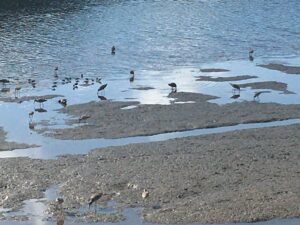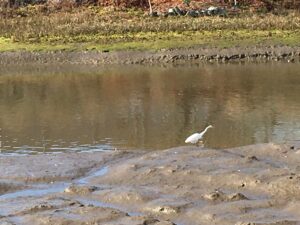The salt marsh is part of the tidal influence zone that experience low and high tides exactly as we see at our local beach.
The lower salt marsh at Rose Creek is the portion of the salt marsh that is inundated with salt water at high tides. As an FYI, San Diego sees two high and two low tides per cycle or roughly per day. There is a high high and a low high as well as a low low and a high low. This portion of the salt marsh has minimum visible plant life.
Mudflats appear barren but conceal a rich variety of life. Many animals depend on this fragile and threatened habitat. The breakdown and decay of plants produce organic debris which is a rich food source for a variety of invertebrates, like snails, slugs algae, fiddler crabs and Amphipods, which range in size from 1 to 340 millimetres (0.039 to 13 in) and are mostly detritivores or scavengers.
These very small animals are an attractive food source for the mudflat’s large bird population, including sand pipers, willets, curlews, and other shore birds. Over 100 species of birds reside in or visit southern California mudflats. Mudflats prevent coastal erosion and occur where fine soils are deposited by fresh water inflow like Rose Creek (as opposed to the course soils on our local beaches).
At high tide the mud flats are under water at low tide the mud flats are exposed.


0 Comments